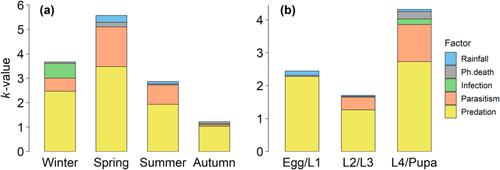当前位置:
X-MOL 学术
›
Ann. Appl. Biol.
›
论文详情
Our official English website, www.x-mol.net, welcomes your feedback! (Note: you will need to create a separate account there.)
Life tables for the diamondback moth (Plutella xylostella) in southeast Brazil indicate ants and spiders as leading mortality factors
Annals of Applied Biology ( IF 2.6 ) Pub Date : 2020-10-13 , DOI: 10.1111/aab.12656 Elizeu S. Farias 1 , Renata C. Santos 1 , Daiane G. Carmo 1 , João R. S. Soares 1 , Thiago L. Costa 1 , Abraão A. Santos 1 , Marcelo C. Picanço 1
Annals of Applied Biology ( IF 2.6 ) Pub Date : 2020-10-13 , DOI: 10.1111/aab.12656 Elizeu S. Farias 1 , Renata C. Santos 1 , Daiane G. Carmo 1 , João R. S. Soares 1 , Thiago L. Costa 1 , Abraão A. Santos 1 , Marcelo C. Picanço 1
Affiliation

|
The diamondback moth (DBM), Plutella xylostella (Lep.: Plutellidae), causes significant losses in Brassica crops. Leaf consumption by the larvae reduces plant yield and causes the contamination of heading brassicas. Chemical control usually provides unsatisfactory results due to the quickly developed resistance of DBM populations to insecticides. Thus, natural control by biotic factors (predators, parasitoids, and entomopathogens) is crucial and should be managed upon knowledge of their role as DBM regulators. The leading mortality factors of DBM across the annual seasons in southeast Brazil were investigated by conducting 57 field life tables for 2 years. The highest and lowest total mortalities of DBM occurred in winter (99.7%) and autumn (94%). Predation was the main mortality factor in all seasons. Marginal parasitism rates were higher in spring and lower in autumn, and Oomyzus sokolowskii (Hym.: Eulophidae) accounted for almost 90% of total parasitism. The highest mortalities by rainfall were recorded in spring (44.5%), while physiological death and infection caused low mortalities (≤ 6%) throughout the seasons. In addition, models were built to investigate the main predators acting on the DBM life stages; Araneae, Brachymyrmex bruchi, and Tetramorium simillimum (Hym.: Formicidae) were the predators associated with egg/L1 predation whereas Solenopsis saevissima, T. simillimum and Camponotus spp. (Hym.: Formicidae) were the ones responsible for L4/pupa predation. The L2/L3 stage was the least affected by predation, and the final model for this stage did not include any predator. In light of these findings, habitat manipulation and insecticide selectivity are discussed as measures to preserve the main predators and parasitoid.
中文翻译:

巴西东南部小菜蛾(Plutella xylostella)的生命表表明,蚂蚁和蜘蛛是主要的死亡因素
小菜蛾(Plutella xylostella)(小菜蛾:Plutellidae)在芸苔属中造成重大损失。庄稼。幼虫消耗叶片会降低植物的产量,并导致抽穗的芸苔属受到污染。由于DBM种群对杀虫剂的快速发展的抗药性,化学控制通常无法提供令人满意的结果。因此,通过生物因子(捕食者,寄生虫和昆虫病原体)进行自然控制至关重要,应在了解其作为DBM调节剂的作用后进行管理。通过进行2年57次田间生命表调查,调查了巴西东南部DBM在整个年度季节中的主要死亡率。DBM的最高和最低总死亡率发生在冬季(99.7%)和秋季(94%)。捕食是所有季节的主要死亡因素。春天的边缘寄生率较高,秋天的边缘寄生率较低,Oomyzus sokolowskii(Hym .: Eulophidae)几乎占总寄生虫的90%。春季记录的死亡率最高(44.5%),而生理死亡和感染导致整个季节的死亡率较低(≤6%)。此外,还建立了模型来调查影响DBM生命阶段的主要掠食者。蜘蛛目,Brachymyrmex bruchi,和铺道simillimum(HYM:蚁科)用蛋/ L1捕食而相关联的天敌红火saevissima,T. simillimum和弓背spp。(Hym.:Formicidae)是负责L4 / pu捕食的动物。L2 / L3阶段受捕食的影响最小,该阶段的最终模型不包括任何捕食者。根据这些发现,讨论了栖息地操纵和杀虫剂选择性作为保护主要捕食者和寄生动物的措施。
更新日期:2020-10-13
中文翻译:

巴西东南部小菜蛾(Plutella xylostella)的生命表表明,蚂蚁和蜘蛛是主要的死亡因素
小菜蛾(Plutella xylostella)(小菜蛾:Plutellidae)在芸苔属中造成重大损失。庄稼。幼虫消耗叶片会降低植物的产量,并导致抽穗的芸苔属受到污染。由于DBM种群对杀虫剂的快速发展的抗药性,化学控制通常无法提供令人满意的结果。因此,通过生物因子(捕食者,寄生虫和昆虫病原体)进行自然控制至关重要,应在了解其作为DBM调节剂的作用后进行管理。通过进行2年57次田间生命表调查,调查了巴西东南部DBM在整个年度季节中的主要死亡率。DBM的最高和最低总死亡率发生在冬季(99.7%)和秋季(94%)。捕食是所有季节的主要死亡因素。春天的边缘寄生率较高,秋天的边缘寄生率较低,Oomyzus sokolowskii(Hym .: Eulophidae)几乎占总寄生虫的90%。春季记录的死亡率最高(44.5%),而生理死亡和感染导致整个季节的死亡率较低(≤6%)。此外,还建立了模型来调查影响DBM生命阶段的主要掠食者。蜘蛛目,Brachymyrmex bruchi,和铺道simillimum(HYM:蚁科)用蛋/ L1捕食而相关联的天敌红火saevissima,T. simillimum和弓背spp。(Hym.:Formicidae)是负责L4 / pu捕食的动物。L2 / L3阶段受捕食的影响最小,该阶段的最终模型不包括任何捕食者。根据这些发现,讨论了栖息地操纵和杀虫剂选择性作为保护主要捕食者和寄生动物的措施。



























 京公网安备 11010802027423号
京公网安备 11010802027423号